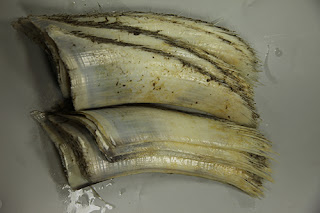Despite the difficulties at the start of the
week, we ended the week well and are aiming to fulfil Jan de Boers motto: “all
is well that ends well”. Jan de Boer is a fisherman from Urk (NL) who joins the
BTS for one week each year.
Ondanks de moeilijkheden bij de start hebben we de week goed beëindigd.
Ik heb deze week weer een Nederlands spreekwoord erbij geleerd van Jan de Boer
(Urk): "een slecht begin is een goed eind"... daar werken wij naartoe met deze
BTS.
Here a
summary of this week’s highlights:
Hier een
samenvatting van de hoogtepunten deze week:
We completed
16 hauls with the 8m beam (the net used for fish data), one with the 2m beam (small net for additional sampling of organisms living on the seabed) and 2 samples with the boxcore (for organisms within the sediment). Here the stations we fished and the ones still to go:
Wij hebben 16
trekken uitgevoerd met de 8m boomkor (het net dat we gebruiken voor de gegevens over onder andere tong en
schol), één met een 2m netje (voor de kleinere beesten op de bodem) en 2
bodemmonsters met de happer (om te zien wat er in de bodem leeft).Hieronder staan de stations die we hebben bevist en de stations die nog
gedaan moeten worden:
Blue points show all stations to be completed, red areas are the ones completed so far.
Blauwe punten geven de stations aan die we moeten vissen en in rood gemarkeert de kwadranten die we tot nu toe hebben gedaan.
We caught 43
species of fish (including sharks and rays) and 96 species of benthos. We measured over 1000 dab and long rough dab and nearly 5000 plaice, but still have the more common fishing grounds ahead of us.
We hebben 43 vissoorten (inclusief haaien en roggen) en 96 soorten benthos (beesten die op de bodem leven) gevangen). In totaal hebben we meer dan 1000 schar en lange schar gemeten en bijna 5000 schollen, maar hebben nog belangrijke platvisgebieden voor ons liggen.
Kees G in the background removing otoliths (earbones to determine age of fish) and Kees V keeping notes of length, weight and sex of each fish.
Kees G op de achtergond snijdt otolieten (gehoorsteentjes om de leeftijd van de vis te bepalen) and Kees V op de voorgrond schrijft alle lengtes, gewichtes en geslachten op.
There was
again an abundance of young plaice in the Moray Firth, a trend that has been
observed with the BTS in previous years. The Moray Firth always throws up some interesting catches and didn’t disappoint this year with one (and subject to identification at the lab possibly two) Greater forkbeard (Phycis blennoides):
In de Moray
Firth vingen we net als in eerdere jaren jongere schol dan in de omliggende
gebieden. In de Moray Firth vangen we ook altijd iets leuks en ook dit jaar hadden we mooie vangsten met bijzondere soorten. Dit jaar gaat de "bijzondere vangst" prijs naar de gaffelkabeljauw (Phycis blennoides):
We completed
the first successful deployments of the boxcore off the Tridens during the BTS. This shows promise for this type of sampling to be incorporated into trawl surveys
in the future, helping us to move towards a more ecosystem focussed survey.
We hebben de
boxcore succesvol kunnen inzetten tijdens deze eerste reis. Dat is interessant
met het oog op de toekomst, aangezien het Europese beleid er op gericht is om
meer gegevens over het hele zee-ecosysteem te verzamelen tijdens de surveys die
we uitvoeren.
After completing our last haul for this week on saturday morning, we are now
docked in Aberdeen harbour for the weekend and will be continuing our journey
early Monday morning, most likely heading east to the German Bight.
Zaterdagochtend deden we nog één trek en daarna zijn we in Aberdeen naar
binnen gegaan. Maandagochtend vroeg gaan we weer verder met de survey,
waarschijnlijk richting Duitse bocht.
Arriving in Aberdeen
Aankomst in Aberdeen

















